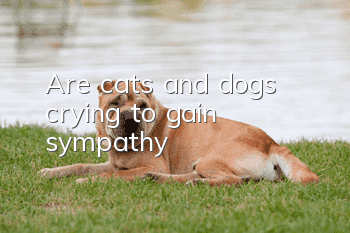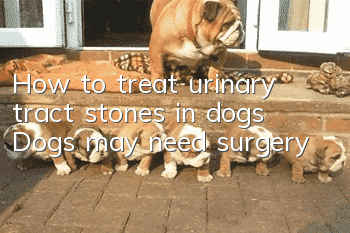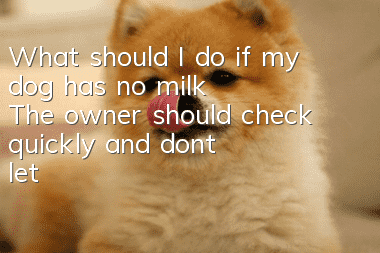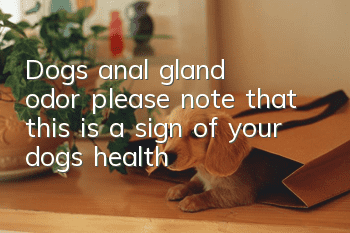Are cats and dogs “crying” to gain sympathy?

It is said that the eyes are the windows to the soul. You can understand someone's full emotions, their thoughts, and their personality through one pair of eyes. A pair of eyes can convey so many things. Even the secretions of the eyes can tell us whether they are healthy or not...
Why cats and dogs cry:
The behavior of cats secreting tears is called epiphora in medical terminology, which means there are too many tears or the tears are overflowing. If not cleaned up in time, they will become tear stains. However, the behavior of epiphora itself does not pose a threat to the health of cats and dogs, mainly because the cause of epiphora is extremely important.
·Teething
When cats (4-7 months old) and dogs (3-6 months old) are changing teeth, various organs and structures in the head are developing, and their speed will suddenly put pressure on the tear ducts.
Note: Cats and dogs will bite some things and grind their claws (cats) to relieve the stress of the teething stage.
· Food
Reactions with additives in food, as well as excessive mineral content in water sources, can lead to excessive tears.
· Ear infection
Since the facial nerve intersects the auditory and facial nerves, when the ear canal is infected by bacteria, viruses, or parasites (or the ear is swollen or painful), the pain deep in the ear canal will extend to around the eyes.
·Special varieties
Flat-faced cats (such as Persians, chinchillas, fattened cats, etc.) and short-nosed dogs (mynas, French bulldogs, etc.) have large curvatures in their nasolacrimal ducts and limited fluid discharge. Even normal secretion cannot bear the burden.
· Eye infection/inflammation
In addition to the fluid, there will be a thick white/yellow discharge around the eyes.
· Tear duct abnormality/blockage
Fluid usually drains from the nose and is drained from the eyes when the tear ducts become blocked.
· Eye irritation
Dirt, foreign matter, allergies, and foreign matter will stimulate cats and dogs to flush them with tears; if the tears continue for more than 2 days, please rush to the hospital for examination immediately.
· Upper respiratory tract diseases
In addition to tears, complications such as sneezing, fever, runny nose, and drooling may occur.
· Conjunctivitis (pink eye)
Mainly caused by infectious respiratoryViral conjunctivitis caused by systemic diseases, the conjunctival congestion, water, and secretions of the eyes increase, and are generally divided into acute and chronic conjunctivitis.
Note: Herpes virus, mycoplasma, chlamydia, blocked tear ducts and drug allergies can all cause conjunctivitis.
· Keratitis
Corneal inflammation/swelling usually caused by herpes viruses; but less commonly, fungi, bacteria, allergies, and dry eyes can also cause keratitis.
· Corneal ulcer
There are scratches on the surface of the eyeball, but the cat or dog did not bother to scratch the eyeball when playing or scratching its ears.
· Excessively long hair/abnormal structure
Excessively long hair around the eyes or structural abnormalities of the eyelashes and eyelids (esotropia, exotropia) will cause constant friction against the cornea of the eye.
In addition to the above reasons, there are other eye diseases that can also cause cats and dogs to secrete tears. Although this breaks your new discovery of emotional communication between cats and dogs, it does not mean that they are "emotionless killers". They are more restrained in their way of communication and require parents to be patient and observe. As long as you understand it, you will find that your feelings will heat up quickly~
NOTE: Cats who have difficulty producing tears are often diagnosed with dry eye and require eye drops to keep their eyes lubricated and stimulate tear production.
How cats and dogs express their emotions:
· Cats will walk around you with their tails and rub you with their heads, behind their ears, and their bodies, leaving their own scent to express their ownership: "If you have physical contact, you are mine";
· Putting paws on your body means that you are very fond of you;
· Licking you means that you have enough trust and intimacy;
· When he sees you, he rolls over and exposes his belly or exposes his little tongue when sleeping. It seems that he is very relaxed in front of you;
· The cat’s whiskers stand up, its front wheels are depressed, its rear wheels twist rapidly, its ears are back, its teeth are exposed, and it makes a "hissing" sound, indicating that it is angry and will attack you if you continue to approach/tease;
· A dog wagging its tail from side to side expresses happiness and excitement, but if you find that its tail is tilted to one side and wagging rapidly, it means that it is in a state of anxiety and anger;
· The tail droops and sticks close to the buttocks to express alertness and uneasiness;
· dogDogs tilt their heads to guess your emotions through your expressions and eyes
- How to make your dog like to eat dog food Four ways to make your dog fall in love with dog food
- How to protect your dog’s food? Teach you tips on training your dog
- What should I do if my dog has lupus? Immune system diseases should not be underestimated
- If your dog's hair is cut and the skin is cut, the flesh is exposed. If the dog's hair is accidentally cut and the skin is cut, it must be disinfected immediately.
- Do dogs need deworming in summer? What should you pay attention to when raising dogs in summer?
- What to do if your dog has indigestion? Dog indigestion is no small matter!
- What should you pay attention to when vaccinating your dog? What should you pay attention to when vaccinating your dog?
- Symptoms of Rheumatism in Dogs What conditions can cause rheumatism in dogs?
- What to do if dogs fight at home? The owner is the best mediator
- What are the reasons why dogs are obese? Do you know these four reasons?



